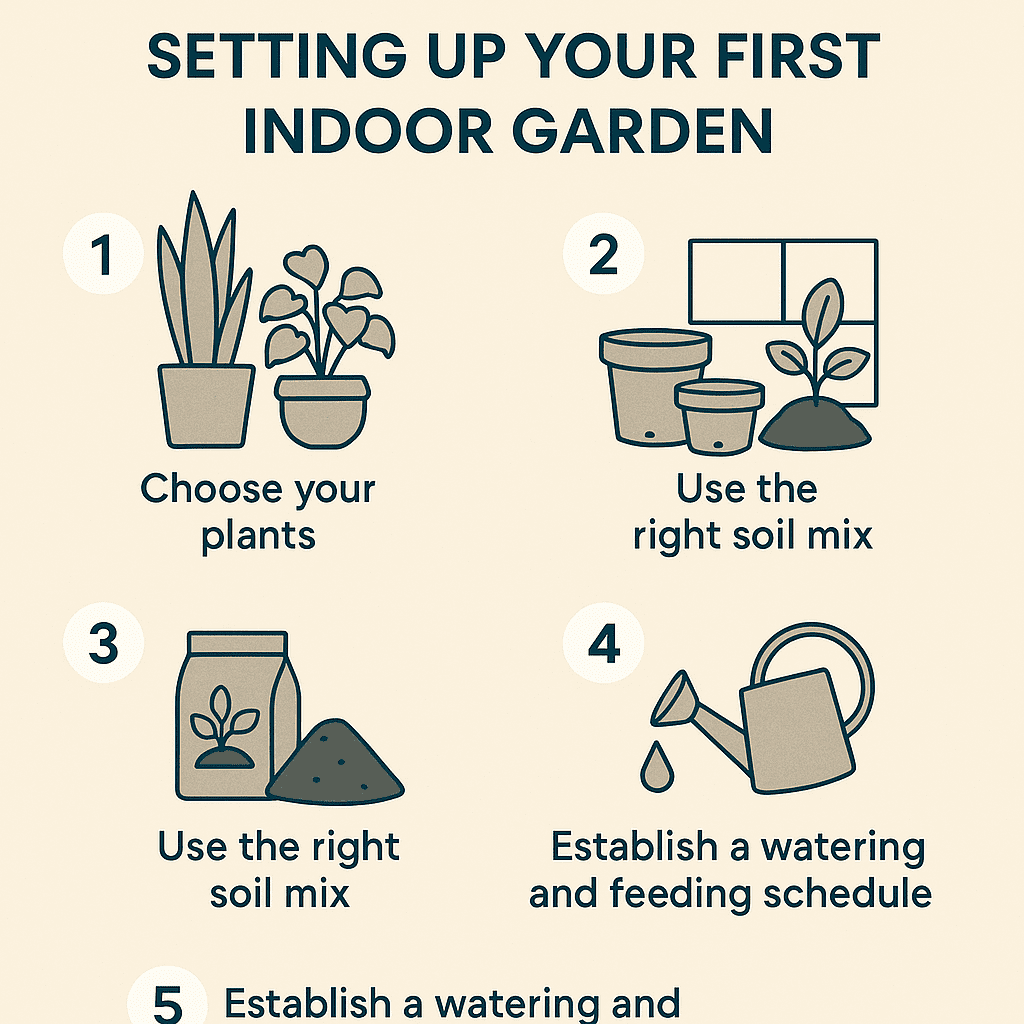Starting an indoor garden can be exciting but also overwhelming for first-time gardeners. Beginner-friendly indoor gardening is all about choosing the right plants that thrive with minimal care, creating a healthy environment, and building confidence in your skills. With the right starter plants and proper guidance, even someone without a “green thumb” can enjoy a lush and vibrant home garden.
This guide will walk you through the best low-maintenance indoor plants, step-by-step care tips, and practical advice to help you grow successfully from day one.
Why Indoor Gardening is Perfect for Beginners
Indoor gardening offers several advantages, especially for people with limited outdoor space or unpredictable weather conditions.
Benefits:
- Year-round growth: Indoor plants are protected from seasonal changes.
- Air purification: Many indoor plants naturally filter harmful toxins from the air.
- Stress relief: Studies show that caring for plants can improve mood and reduce stress.
- Compact space: Perfect for apartments, small homes, or shared living spaces.
Choosing the Right Starter Plants
When starting your indoor gardening journey, focus on low-maintenance plants that are forgiving if you forget to water them or if lighting isn’t perfect.
Top Beginner-Friendly Indoor Plants:
- Snake Plant (Sansevieria): Tolerates low light and infrequent watering.
- Pothos (Epipremnum aureum): Grows quickly and adapts to various light conditions.
- Spider Plant (Chlorophytum comosum): Easy to propagate and resistant to pests.
- Peace Lily (Spathiphyllum): Thrives in shade and improves indoor air quality.
- ZZ Plant (Zamioculcas zamiifolia): Extremely drought-tolerant and resilient.
💡 Pro Tip: Start with two or three varieties so you can learn different care needs without feeling overwhelmed.
Understanding Light Requirements
Light is the most critical factor in indoor plant growth. Each plant species has specific needs, and matching them to your home’s lighting conditions ensures healthy development.
Types of Light:
- Bright indirect light: Near a window but not directly in the sun (ideal for Pothos and Peace Lily).
- Low light: A few feet away from a north-facing window (great for Snake Plant and ZZ Plant).
- Direct sunlight: Intense light for at least 6 hours a day (succulents and cacti prefer this).
Quick Tip:
If your home lacks natural light, invest in a full-spectrum grow light to mimic sunlight and keep plants thriving.

Watering Basics for Beginners
Overwatering is one of the most common mistakes new indoor gardeners make.
How to Water Correctly:
- Check the soil moisture: Insert your finger about an inch deep—if it’s dry, it’s time to water.
- Avoid waterlogging: Ensure pots have drainage holes.
- Follow a routine: Most indoor plants prefer watering once every 1–2 weeks, depending on humidity and temperature.
💡 Pro Tip: Use room-temperature water to prevent shocking plant roots.
Soil and Potting Tips
Choosing the right soil mix is essential for healthy plant growth.
- General houseplant mix: Works for most indoor plants.
- Cactus and succulent mix: Drains quickly to prevent root rot.
- Orchid mix: Specially designed for proper air circulation around roots.
Always repot plants every 12–18 months or when roots outgrow the pot.
Fertilizing for Healthy Growth
Plants need nutrients to grow, especially in pots where the soil’s minerals can deplete over time.
- Liquid fertilizers: Easy to dilute and apply during watering.
- Slow-release pellets: Provide nutrients gradually over weeks.
- Feeding schedule: Every 4–6 weeks during the growing season (spring and summer), and less during winter.
Common Indoor Gardening Mistakes to Avoid
- Overwatering – Leads to root rot.
- Too little light – Causes slow growth and pale leaves.
- Wrong plant for environment – Some plants can’t survive in low-humidity homes.
- Ignoring pests – Check leaves regularly for spider mites or aphids.
Step-by-Step: Setting Up Your First Indoor Garden
- Choose your plants based on your home’s lighting and space.
- Select appropriate pots with drainage holes.
- Use the right soil mix for each plant type.
- Place plants strategically to maximize light exposure.
- Establish a watering and feeding schedule and stick to it.
For more tips on sunlight, watering, and plant spacing, check out our full guide here.
Conclusion
Indoor gardening doesn’t have to be complicated. By starting with beginner-friendly plants, providing the right light, and following simple care routines, you’ll create a thriving indoor oasis in no time.
🌱 Save this guide for your next planting weekend! And share it with a friend who’s just starting their gardening journey—it’s always more fun to grow together.
FAQs
1. What is the easiest indoor plant for complete beginners?
Snake plants are often considered the easiest due to their ability to survive in low light and with minimal watering.
2. How often should I water my indoor plants?
Most indoor plants do well with watering every 1–2 weeks, but always check the soil before adding water.
3. Can indoor plants survive without sunlight?
While no plant can thrive in total darkness, some tolerate low-light conditions and can live with artificial grow lights.
Looking for high-quality pots and soil mixes? You can find a great selection here on Amazon.”
Written by Kate Smith | Plant Care Enthusiast & Urban Gardener
